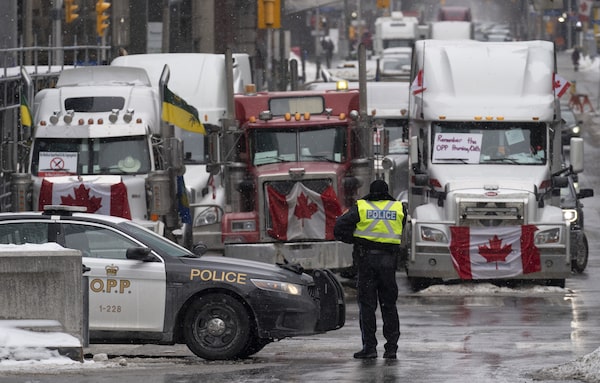
Police at a barricade in front of vehicles parked as part of the trucker protest, on Feb. 8, in Ottawa’s downtown core.Adrian Wyld/The Canadian Press
Andrew Cohen is a journalist, professor at Carleton University and author of The Unfinished Canadian: The People We Are.
In deepest Rockcliffe Park, Ottawa’s toniest enclave, lies a hidden natural phenomenon: a shaded pocket of water filling a former sand and gravel pit. “The Pond,” a local secret, is much beloved in summer by swimmers, sunbathers and naturalists.
In winter, though, the Pond is as accessible as Chernobyl. A black chain-link fence surrounds it. Yellow “caution” tape strung across a flight of stairs to the shore suggests a crime scene; the offenders are apparently hardy swimmers guilty of breaking the ice and entering the forbidden water. Everywhere, the signs scream: “Do not climb!” “Do not enter!” “No dogs!” “Thin ice!” “No smoking!”
The other day, I savoured the quiet as I stood in mounds of sugary snow. Every moment or so, depending on the wind, brought cacophony from the big trucks downtown.
The absurdity was striking. Here, at the Pond, the mirthless city that forced kids to dismantle a lemonade stand was doing its stern, finger-wagging best to protect us from pleasure. There, at Parliament Hill, it was doing its feckless, forelock-tugging worst to wish away peril.
As we know, the City of Ottawa did almost nothing to stop what Mayor Jim Watson called a state of emergency. Nothing. In the first week, the now-former police chief, Peter Sloly, offered daily self-congratulation for avoiding violence. Later, Mr. Watson tried to negotiate with the truckers – a fruitless exercise in appeasement.
Protesters go for a soak in an inflatable hot tub along Wellington Street across from the West Block on Parliament Hill on Feb. 17.Justin Tang/The Canadian Press
It took Zexi Li, a heroic young public servant, to get a court injunction to stop the ear-piercing honking. And the federal government, finally, to organize a police intervention to stop the carnival of intimidation. Effectively, this made Ottawa its ward.
The occupation of Ottawa was the apotheosis of an inept city. How could this happen in the capital of a G7 country? Easily, actually, if you have an autocratic mayor, a weak city council and a contented constituency.
Ottawa no longer sees itself as a national capital. It is innocent of the vision, ambition and confidence that created Canada. Its functionaries do little more than clear snow, collect garbage, raise taxes and patch its gouged streets, which a foreign diplomat calls worse than Jakarta’s.
Yes, yes, Ottawa has many blessings: tidy neighbourhoods; two growing universities; a pleasant municipal art gallery; the Rideau Canal and its grassy banks; the coppered and chimneyed Parliament; the art deco Supreme Court; and the shimmering National Gallery. Ottawa overlooks the Ottawa River to the glorious Gatineau Park.
I witnessed the creation of the Emergencies Act. It shouldn’t have been invoked in Ottawa
Protesters need to understand: Canada’s Charter is not the U.S. Bill of Rights
Spiritually and aesthetically, though, Ottawa is insipid and ugly. It has soulless federal office buildings and a Brutalist concrete bunker for a crumbling central library. Bank Street, its commercial downtown thoroughfare, is a varicose vein. The Byward Market is tired. The Sparks Street Mall is dead.
It’s not just how it looks or feels. In one enterprise after another, Ottawa falls short. It is easily satisfied with mediocrity. As New York was said to be a town without foreplay, Ottawa is a city without climax.
Ottawa opened its hockey arena in the suburbs in 1996, just when Washington and other sensible cities were bringing theirs downtown. It blew a once-in-a-century opportunity to create something bold on roughly 40 acres at Lansdowne Park, settling for chain stores and a flawed football stadium.
It approved a proposed expansion (now modified) of the gothic Chateau Laurier that looked like a carbuncle. Its planned central library is outside downtown on empty LeBreton Flats; it will be smaller and less daring than other new libraries such as Calgary’s. Ottawa’s marquee failure, its greatest institutional collapse, is its light rail system, a comic opera so unfunny that the province is holding a public inquiry.
Ottawa no longer sees itself as a national capital. It is innocent of the vision, ambition and confidence which created Canada.BRETT GUNDLOCK/The New York Times News Service
All this happens in Ottawa because it’s cheap and pinched, terrified of an ambush of imagination. This has much to do with Mr. Watson, a former councillor and mayor who returned in 2010 to lead the newly amalgamated city. The nadir of his brittle, petty stewardship came in a surreal session of city council last week that descended into a teary shouting match over the hiring of a replacement for Mr. Sloly.
Mr. Watson is not running for re-election. The city’s political culture is so depleted it produces a thin field led by Bob Chiarelli, the former mayor who is 80, and Diane Deans, the dismissed chair of the Police Services Board who blithely refused to say why, in a crisis, the police chief was no longer police chief.
Ottawa desperately needs a civic reform movement, fired by progressive grassroots organizations such as Horizon Ottawa. After decades of decline, it needs to reimagine itself, to abandon its suffocating parochialism and numbing complacency. Only then can it embrace a future as a green, clean, smart, kicking, aspiring Nordic metropolis, finally with a real idea of itself.
Editor’s note: (Feb. 25, 2022): An earlier version of this column incorrectly referred to G8 nations. This version has been corrected.
Keep your Opinions sharp and informed. Get the Opinion newsletter. Sign up today.